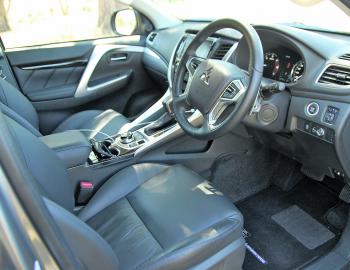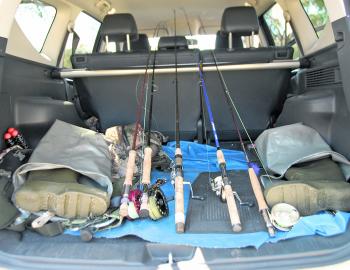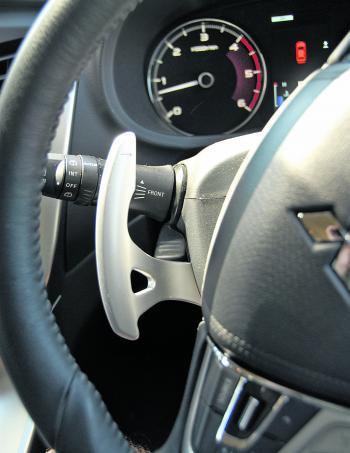As replacement for the Challenger, the new Pajero Sport appears to have taken off from where its predecessor finished and then raised the bar.
For a ute-based family wagon (the Sport is derived from Mitsubishi’s Triton) there’s some serious off-road capability, and great economy from a smaller but quite powerful diesel engine. The cabin also has an upmarket feel when compared to similar ute-derived wagons. Topping these attributes is a very competitive price, plus a 5-year 100,000km warranty and capped price servicing.
Along with its handy family size and 5-star ANCAP rating, the Sport comes with a host of audio and media features as standard. There’s Smartphone Link Display Audio with a 7” touch screen, Android Auto, Apple Car Play, digital audio broadcast radio, along with two USB inputs plus a HDMI output within the centre console, which is elevated to make them highly accessible. As you’d expect, there’s also iPod control, Bluetooth phone connectivity and audio streaming.
Sat nav is not standard in the Pajero Sport. Navigation requires a compatible smart phone linked by cable via Android Auto or Apple Car Play to navigate.
The 5-seat Pajero Sport is a great looking vehicle with ample ground clearance. With LED daylight running lights up front and vertical rear combination LED lamps each side of the top opening rear cargo door, it’s a head turner. Styling is still distinctly Mitsubishi.
The Sport’s interior is upmarket with piano black sections and subtle contrasting panels in the forward cabin and dash area. There are plenty of soft touches around the doors as well. I reviewed the GLS model, and in the test vehicle there was leather seating all round plus electronic adjustment for both driver and passenger. Dual zone climate air was also standard, as was an electronic function for virtually everything, including the folding outside mirrors.
The Pajero Sport had a good driving position, thanks to tilt and telescopic steering wheel adjustment, and the fully adjustable seating was as good as it gets. Some spirited driving saw the steering able to handle back roads just as easily as the best bitumen, although its fairly high centre of gravity saw the Sport in need of a bit of extra guidance in hard corners.
Even on gravel back roads the ride was more than acceptable. There was only the occasional severe bump intruding into the cabin, thanks to the Sport’s refined handling and suspension package with its multi-link rear end treatment, double wishbone and coil springs/stabilizer bar up front.
The Pajero Sport uses the 2016 Triton’s 4-cylinder, 16 valve 2.4L common rail turbo diesel turning out 133kW at 3500rpm and 430Nm at 2500rpm. The engine, despite its modest size compared to some of today’s diesels, was certainly not lacking in power. The smooth diesel was super quiet around town, tractable and willing to go hard.
The unit’s brilliant 8-speed auto unit featured a very low first gear and a high ratio eighth gear. Prominent wheel mounted paddles are there for drivers who like to play with their auto unit’s ratios up hills and twisty roads, but I left the auto to do its own thing which it did seamlessly. Even under hard acceleration the gear changes were undetectable.
I have a ‘thing’ about some 6-speed or 8-speed auto units, especially if they just don’t work at highway speeds. One very well known 4WD will not slip into highest gear until around 120km, so I was chuffed to slip the Sport’s gear selector to the right at 98km/h to see that the auto unit was actually in eighth gear – thus saving revs and maximising fuel economy. I averaged 9.1L per 100km on a mix of city and country driving.
While rear leg room is excellent, head room is never going to be class leading. Still, very tall rear seat passengers are able to adjust the back rest to a slightly reclining position to help with this. Isofix child seat anchor points come standard.
Rear seats tumble forward at the touch of a button and the cargo space is over 1.8m in length.
The old Challenger was always good for an off-road run, and the new Sport lifts the bar again. It has 18” wheels, 218mm ground clearance, 30° approach angle and 25° departure angle plus a wading depth of 700mm. With high/low range gear selection at the touch of a console knob, things could not be easier.
I liked the strong engine braking of the Sport in low range first. With Hill Descent engaged and that very low gearing, it was reminiscent of the very useful braking I’ve experienced from a manual box in low first gear. The road-based 4High system even offers a 4HLc setting that locks the centre diff; very important for beach work, especially if you’re towing, where a combination of momentum and traction can prevent you from being bogged in the soft stuff.
In all, the Pajero Sport is a true value for money off-road package with a cabin layout and equipment list that is very hard to top for the money. The Sport can also out-tow (750kg for an unbraked trailer, 3100kg for braked) and go further off-road than many urban off roaders. Prices range from around $45,000-$53,000.
Reads: 4254
The Pajero Sport is great in the bush, making easy work of a run to a cod hole.

The high centre console makes electronic functions easily accessible.

Even with the rear seat up there’s still a lot of cargo space.

Plenty of ground clearance and a sensible approach angle give the Pajero Sport genuine off-road cred.

Big steering column paddles will please drivers who likes to play with gear ratios.




